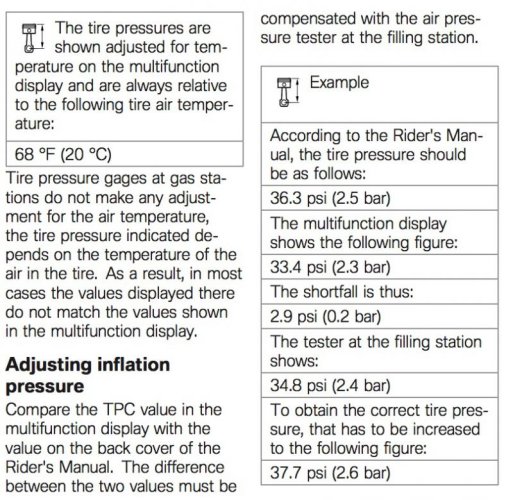ncpbmw1953
Member
I know the conventional wisdom including in the rider manual you are to set tire pressure w/ a gauge on a cold tire. And also I get the sense people trust a $30 digital over TPM's readout but I'm not sure why considering the tire pressure gauge presumably isn't temperature-compensated. You can ride in ambient temps from 40F to 90F and TPM will display the pressure as unchanged because of the temperature-compensation logic that TPM utilizes.
I can't see why you couldn't get accurate pressure adjustment by adding or removing air using the TPM readout on a road-warmed tire. So let's say your road-warmed front tire pressure reads 36psi, and you'd like it to be 38. Simply stop, leave the ignition on and add air until TPM displays 38psi. Why would this not be the most accurate way to set tire pressure? I stopped the bike once and took a little air out once on a warm tire and noticed TPM did drop down in real time w/o the wheels turning as I left the ignition turned on.
The excerpt below from the rider manual seems to be saying they consider TPM to be the benchmark and adjusting pressure using a filling station pressure gauge requires you to take into account the temperature compensation, no?

I can't see why you couldn't get accurate pressure adjustment by adding or removing air using the TPM readout on a road-warmed tire. So let's say your road-warmed front tire pressure reads 36psi, and you'd like it to be 38. Simply stop, leave the ignition on and add air until TPM displays 38psi. Why would this not be the most accurate way to set tire pressure? I stopped the bike once and took a little air out once on a warm tire and noticed TPM did drop down in real time w/o the wheels turning as I left the ignition turned on.
The excerpt below from the rider manual seems to be saying they consider TPM to be the benchmark and adjusting pressure using a filling station pressure gauge requires you to take into account the temperature compensation, no?




